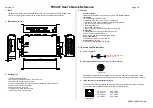
Ossila Slot-Die Coater
User Manual
Ossila.com
34
Ossila Limited © 2019
10.
The Coating Process
When using volatile solvents, place the slot-die coater within a fume hood or
controlled environment (e.g. a glovebox).
To use the slot-die coater, a general start-up procedure should be followed before coating
should begin. There are several stages to this:
i.
Installing the slot-die head (
Section 9.2.5
)
ii.
Setting the hotplate temperature (
Section 9.2.2
)
iii.
Levelling the stage (
Section
9.2.6
)
iv.
Installing the syringe (
Section 9.2.7
)
v.
Aligning the slot-die head with the substrate (
Section 9.2.8
)
vi.
Forming a meniscus (
Section 9.2.9
)
vii.
Setting the coating parameters & running the program (
Section 9.2.10
)
10.1
Gap Height
The gap between the slot-die head and the substrate is important to coat a defect-free film. For an in-
depth explanation of this please
refer to Ossila’s “
Slot-Die Coating: Guide to Troubleshooting Defects
”
(
https://www.ossila.com/pages/slot-die-coating-defect-troubleshooting
).
To know the minimum gap height for coating a stable film you must first know what wet film thickness
you are wanting to coat. If you are working from a dry film, you must begin by calculating the
percentage volume of solids in solution. This can be done if the mass of the liquid, the mass of the
solid, the density of the liquid, and the density of the solid are all known.
Volume %
Solids
=
mass
solid
density
solid
mass
liquid
density
liquid
+
mass
solid
density
solid
The needed wet film thickness (
t
wet
) can then be calculated from final desired dry film thickness (
t
dry
):
t
wet
=
t
dry
Volume %
Solids
As an initial number to work with, the viscous model approximation can be used. For this gap height
(
h)
should be less than double the wet film thickness:
h < 2(t
wet
)
It should be noted that the gap height above is only true for solutions with capillary numbers greater
than approximately 0.1 to 0.25. For low capillary number solutions, where the viscosity or the speed
of the stage is low, the minimum gap height is controlled by the equation below, where
𝐶
𝑎
is the
capillary number. This means higher gap heights can be used for low viscosity solutions.
h
t
wet
= 0.67. 𝐶
𝑎
2
3








































